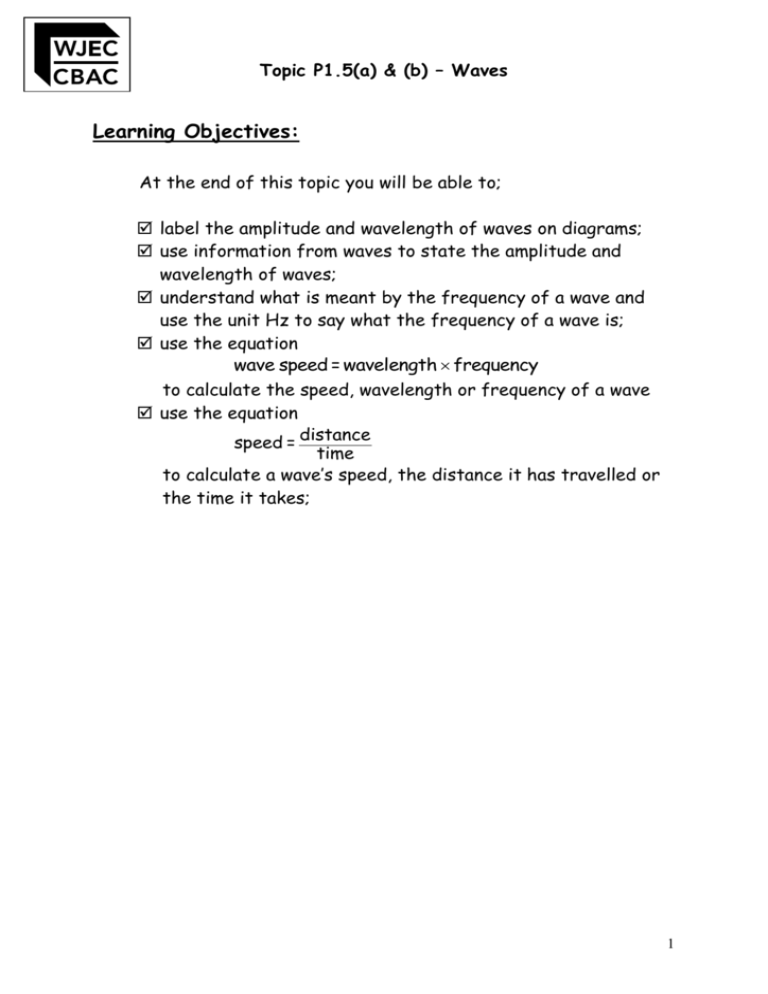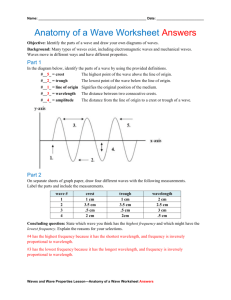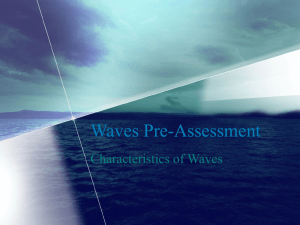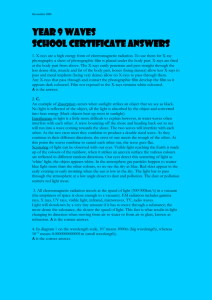Waves - WJEC
advertisement

Topic P1.5(a) & (b) – Waves Learning Objectives: At the end of this topic you will be able to; label the amplitude and wavelength of waves on diagrams; use information from waves to state the amplitude and wavelength of waves; understand what is meant by the frequency of a wave and use the unit Hz to say what the frequency of a wave is; use the equation wave speed = wavelength frequency to calculate the speed, wavelength or frequency of a wave use the equation speed = distance time to calculate a wave’s speed, the distance it has travelled or the time it takes; 1 Topic P1.5(a) & (b) - Waves What is a wave? We are used to waves on the sea which look something like this, if we imagine looking at them from the side: The whole shape moves along like this: etc. There are lots of other kinds of waves, most of which we cannot see, e.g. sound waves, earthquake waves, light waves, so what have they all got in common? They all involve vibrations / oscillations. They all transmit energy They all move through a material (or space) without the material moving along too. 2 Topic P1.5(a) & (b) – Waves Describing waves: Look at the following diagrams of waves [the waves extend left and right outside the diagrams – we are only seeing a small section of each wave]: A B C D What is different in the diagrams? We need some words to help us: peak 1 cycle trough We could say, “Diagram C has 6 cycles but diagram B has only 2.” We could say, “The peaks in diagram B are higher than any of the others and D has the lowest peaks.” 2 new words: Wavelength – this is the length of 1 cycle Amplitude: this is the height of the peak (above the midline) or the depth of the trough (below the midline) wavelength amplitude amplitude wavelength 3 Topic P1.5(a) & (b) - Waves A few questions: Question 1. Which of the waves A, B, C or D has the largest amplitude? …………… Question 2. Which of the waves A, B, C or D has the largest wavelength? ………… Question 3. Which of the waves A, B, C or D has the smallest amplitude? …………. Question 4. Which of the waves A, B, C or D has the smallest wavelength? ……… Question 5. Which of the waves B, C or D has a wavelength which is half as large as wave A? …………… Question 6. For the following diagram of a wave which is drawn on a graph grid: height (m) 4 2 0 distance (m) 1 2 3 4 5 2 4 (a) label a peak; (b) label a trough; (c) state the amplitude of the wave; ………………….. m (d) state the wavelength of the wave. ………………... m. Now check your answers with those at the bottom of the page:1 How did you get on? If you got them all right, well done. If not, try and see where you went wrong or check with your teacher. 1 1. B, 2. B, 3. D, 4. C, 5. C, 6.(c) 4 m, (d) 2.5 m 4 Topic P1.5(a) & (b) – Waves More ways of describing waves One important aspect of waves is that they move, so we can describe a wave in terms of how fast it moves, i.e. its speed. This works in just the same way as for people or cars or aeroplanes. e.g. The speed of sound waves in air is 330 m/s. It takes the sound from a lightning stroke (i.e. the thunder) 8 seconds to reach a person. How far away was the lightning? Equation: distance = speed time Put in the numbers: So distance = 330 m/s 8 s distance = 2640 m [Note: Lots of people think that the distance away in miles is the same as the time delay in seconds. This is not true. Every 3 seconds is approximately 1 km; every 5 seconds is approximately 1 mile!] Another feature of waves is how often the peaks and troughs arrive – we call this the frequency. It is expressed in “hertz” – abbreviated to Hz.2 If a wave has a frequency of 30 Hertz, that means that 30 cycles of the wave arrive every second. Waves sometimes have very high frequencies. We can hear sound waves with frequencies higher than 10 000 Hz. Radio 4 long wave is transmitted using radio waves with a frequency of 198 000 Hz. 1 FM has a frequency of about 98 000 000 Hz. Because of this we use the usual SI multipliers k (kilo = 1000) and M (mega = 1 million), to express the above frequencies as: 10 kHz; 198 kHz; 98 MHz. 2 This unit is named after the German scientist Heinrich Hertz, who was the first person to demonstrate radio waves. Because the unit is a person’s name, the first letter – H – is written as a capital, just like the N in 10 N (force). 5 Topic P1.5(a) & (b) - Waves Wavelength, frequency and speed These three wave quantities are connected by an equation. Think about a wave going past you with a wavelength of 3 metres. Suppose it has a frequency of 4 Hz, how fast is it going? 4 Hz means that 4 cycles of the wave go past you every second. Each cycle of the wave is 3 m long, so the wave must move 3 4 = 12 m every second; i.e. its speed is 12 m/s. So the equation must be: wave speed = wavelength frequency wave speed We can also write this equation as: wavelength = frequency wave speed or frequency = wavelength Example 1: The speed of sound is 330 m/s. Calculate the wavelength of a sound wave which has a frequency of 3.3 kHz. Equation first: wavelength = wave speed frequency 3.3 kHz = 3300 Hz, so wavelength = 330 m/s = 0.1 m [= 10 cm] 3300 Hz Advice for Higher tier: Sometimes you will be given an equation which needs to be re-arranged when you use it. So, in the last example, the equation might have been written: wave speed = wavelength frequency The advice is: put the numbers in first and then swap the equation around. This is because the first mark is given for putting numbers into a correct equation. You’ll lose this mark if you swap the equation round incorrectly before you put the numbers in. So: wave speed = wavelength frequency Then: 330 m/s = wavelength 3300 Hz [ - 1st mark in the bag!] 330 So: wavelength = [ 2nd mark] = 0.1 m [ 3rd mark] 3300 [If the question has only 2 marks – you’ll still get the first one this way.] 6 Topic P1.5(a) & (b) – Waves Calculations which you’ll only see at higher tier Some waves, especially Light waves and Infra-red waves have a very high speed. It is 300 000 000 m/s. Its frequency is also very high – the wavelength of the orange light given out by sodium lamps is about 0.000 000 4 m. Because these numbers are so inconveniently in size, we use standard form to write them: Speed of light in air = 3 108 m/s Wavelength = 4 10-7 m You need to make sure that you know how to use these numbers – and how to enter them into your calculator. Example 2. Use the equation: wave speed = wavelength frequency and the information above to calculate the frequency of the sodium light. Equation first: wave speed = wavelength frequency Numbers in: Rearrange: Answer 3 108 = 4 107 frequency 3 108 frequency = 4 ×10-7 frequency = 7.5 1014 Hz Example 3. A trawler is in a heavy swell. The trawler captain notices that his boat moves up and down with the waves 12 times every minute and that the waves are 40 metres from peak to peak. Calculate the speed of the waves. [This is more difficult because we need to sort out what we know.] Wavelength: that’s easy = 40 m Frequency: More difficult. If there are 12 waves every minute, the number of waves per second is 12 ÷ 60 = 0.2, so the frequency = 0.2 Hz So: wave speed = wavelength frequency wave speed = 40 m 0.2 Hz wave speed = 8 m/s 7 Topic P1.5(a) & (b) - Waves Past paper questions 1. The diagram shows waves travelling from deep water into shallow water. (a)(i) Add an arrow labelled A to the diagram, to show the amplitude of the wave. (ii) Add an arrow labelled W to the diagram, to show the wavelength of the wave. (b) 2. [1] [1] As the wave travels into the shallow water, its wavelength gets shorter and its amplitude decreases. Use this information to complete the diagram to show the waves in shallow water. [2] The diagram represents a wave on the ocean. (a) Use the information given in the diagram to find: (i) the wavelength of the wave: (ii) the amplitude of the wave. (b) Wavelength = …………… m Amplitude =……………. m [2] The frequency of the wave is 0·14 Hz. Use the equation wave speed = frequency × wavelength to calculate the speed of the wave. [2] Speed = ………………..m/s 8 Topic P1.5(a) & (b) – Waves 3. The diagram below shows a wave. (a ) (i) How many complete waves are shown in the diagram? Wavelength = …………….. cm [1] (ii) Write down the wavelength. Amplitude = ……………...cm [1] (iii) Write down the amplitude. (b) …………………[1] The wave travels with a speed of 160 cm/s. Use the equation frequency wavespeed wavelength to calculate the frequency of the wave. [2] Frequency = ………………Hz 4. The diagram shows the side view of a wave. Which label, A, B, C, D, E or F, represents (i) the wavelength of the wave? (ii) the amplitude of the wave? ………….. ………….. [2] 9 Topic P1.5(a) & (b) - Waves 5. Red light travels to us from the Sun at a speed of 3 × 108 m/s. It has a frequency of 5 × 1014Hz. Write down in words, an equation as it appears on page 2 and use it to calculate the wavelength of this red light. Note: The numerical questions here refer to equations on page 2. A set of equations is printed on the inside cover of all GCSE Physics papers. The equations are all the ones from a particular unit, not all of which will be needed. Equation: …………………………………………………………………………………………... ………………………………………………………………………………………………… [1] Calculation: [2] Wavelength = ………………… m 6. A microwave signal, of frequency 5 × 109 Hz and speed 3 × 108 m/s, carries TV pictures from a studio to a geostationary satellite 3·6 × 107 m above the equator. The satellite receives the signal and then transmits it back to Earth, where it is received by homes with ‘satellite dishes.’ (i) Write down an equation, as it appears on page 2, and use it to calculate the wavelength of the microwave signal. Equation: ………………………………………………………………………………………... ……………………………………………………………………………………………… Calculation: [1] [2] Wavelength = ………………… m (ii) Select an equation and then use it to calculate the time for the TV pictures to travel from the studio to the homes of viewers. Equation: ………………………………………………………………………………………... ……………………………………………………………………………………………… Calculation: [1] [2] Time = ………………… s 10 Topic P1.5(a) & (b) – Waves 7. On December 26th 2004, an earthquake under the Indian Ocean sent out a tsunami wave that travelled with terrific speed. The diagram shows the earthquake’s shock wave that was detected in China. (i) Write down the maximum amplitude of the wave. ………………….units [1] (ii) How many complete waves [cycles] are shown? ……………………….[1] (iii) The frequency of the shock wave is 50 Hz and it travelled with a speed of 5 000 m/s Explain what a frequency of 50 Hz means. [1] ……………………………………………………………………………………………………… ……………………………………………………………………………………………………… (iv) Write down in words, an equation as it appears on page 2 and use it with the data in part (iii) to calculate the wavelength of the wave. Equation: ……………………………………………………………………………………… …………………………………………………………………………………………….. [1] Calculation: [2] Wavelength = ……………………… m 11 Topic P1.5(a) & (b) - Waves 8. The diagrams show three different waves A, B and C. (a) Fill in the gaps in the table below. Diagram Wavelength (m) Amplitude (cm) A 4 4 B 2 C ……………………. ………………….. 5 (b) (i) The frequency of wave A is 75 Hz. Use the equation Wave speed = wavelength × frequency to calculate the wave speed of wave A. [2] wave speed = …………………. (ii) The three waves A, B and C all travel at the same speed. State which wave has the lowest frequency. 12 ……………………..[1] Topic P1.5(a) & (b) – Waves 9. Infra-red radiation of frequency 4 1013 Hz has a wavelength of 5 106 m in a glass fibre. (i) Write down an equation from page 2 and use it to calculate the speed of the infra-red radiation in the glass fibre. Equation: ……………………………………………………………………………………… …………………………………………………………………………………………….. [1] Calculation: [2] Speed = ………………………… m/s (ii) Write down an equation from page 2 and use it to calculate the time taken by an infra red signal to travel along a glass fibre 10 km long. Equation: ……………………………………………………………………………………… …………………………………………………………………………………………….. [1] Calculation: [3] Time = ………………………… s 13







